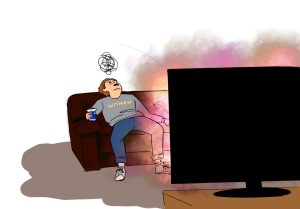 “Slumdog Millionaire” is an unlikely fairy-tale, told in raw fashion by its diverse and genre-less director Danny Boyle (“Trainspotting”, “Millions”, “28 Days Later”).
“Slumdog Millionaire” is an unlikely fairy-tale, told in raw fashion by its diverse and genre-less director Danny Boyle (“Trainspotting”, “Millions”, “28 Days Later”).
The very moment that the projection hits the screen, the film switches to full speed and drives the audience with a compelling, action-packed story that never once slows down. When I first heard about it, the premise seemed absurdly stupid to me: its plot is framed within the Indian version of “Who Wants to be a Millionaire.” Though it begins with aforementioned “slumdog” Jamal (Dev Patel) on the verge of winning 1 million rupees, the film effortlessly intertwines the past and the present with a question & answer narrative that stirs up painfully vivid memories of his childhood on the rough streets of Mumbai. All filmmakers should take notes from “Slumdog” on how to do flashbacks correctly, because there’s not one sense of cliché in Boyle’s editing.
Jamal and his older brother Salim fight their way through life after their mother is killed during anti-Muslim riots in the slums. Together, they end up nomadically moving through the country with a shy young eight-year-old girl named Latika (Rubiana Ali), who they meet during the attack. Young Jamal (Ayush Mahesh Khedekar) falls in love with Latika, which triggers the story that next unravels on the screen, including the only reason he is now on the game show.
The actors who play the younger versions of the three main characters are all non-professionals, hired straight off the Indian streets. They do an amazing job, keeping the viewers on the edge of their seats as they go through very real and painful events that still take place on the streets of third-world countries around the world. Imagine seeing a much more brutal and realistic version of “Oliver Twist” where singing is probably the last thing you’d want to accompany the difficult scenes on display here. (Although, the villain in “Slumdog” happens to make his children sing too – for all the wrong reasons.)
Boyle delivers some beautiful footage, filled with extremely vivid colors that scream their way off the screen and into the audience’s eyes. His seductive visual style is brilliant, and the soundtrack by composer A.R. Rahman, that also features M.I.A., complements his ‘in-your-face’ rapid filming perfectly. All of the elements come together flawlessly, and I really felt like I was travelling along with Jamal on his journey.
The story is irrefutably compelling and interesting to watch which makes Doyle’s job, keeping viewers entertained, just that much easier. My only qualm is that the film makes for a great viewing experience, and indeed is a great film, but not one that lingers in the mind for hours after the credits finish rolling.
It also has a rather corny ending, which really ruined it for me, but Boyle makes up for it with the creative credits, included to show us that “it’s okay to move on, it was just a movie.” But for me, a great film must inspire change – not completely morph you, but affect you in some way so that life is just a bit different after the film finishes. The movie is still quite an achievement that is most definitely worth watching, in fact one of the best films released this year. It’s already taken home a bunch of Golden Globes (including Best Picture); you decide how many Oscars it deserves.













